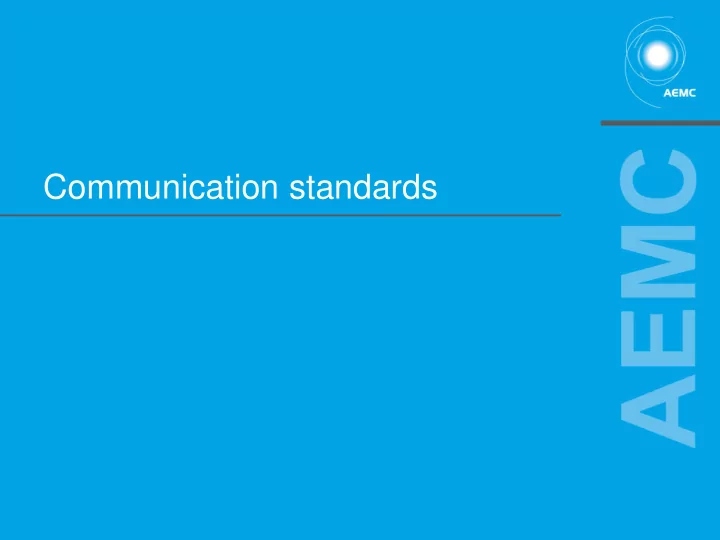

Communication standards AEMC PAGE 1
Market protocol – international • ToR requires us to consider suitable internationally accepted protocols. – Are there any internationally accepted market or meter protocols that could be used as the common market protocol? • Options – meter protocols – DLMS/COSEM generally regarded as the most advanced internationally accepted meter protocol, being used in many places in Europe and South East Asia – ANSI used in North America and Victoria AEMC PAGE 2
Market protocol – international • Stakeholders views on DLMS and ANSI – DLMS generally regarded as more developed than ANSI – Market protocol should be services based, rather than function based – Innovation may be slow if new functions and services not already in DLMS, although many functions already exist in overseas implementations • Options – market (services based) protocols – IEC 61968 is services based but not well developed yet AEMC PAGE 3
Market protocol – NEM specific • Options – market (services based) protocols – Start with a clean sheet of paper – Build on the existing B2B hub • Advantages of B2B – B2B already defines and implements a set of related services. – Governance arrangements already in place, although may require review – Likely to deliver an initial implantation more quickly than starting from scratch – Performance of existing system can be extended if required • Recommend market protocol based on existing B2B arrangements AEMC PAGE 4
Should there be a single common market protocol for all communications for metering services? • Paradox – stakeholders want – a common market protocol (efficiency and barriers to entry) – flexibility for new services (outside of common protocol) • Interoperability promoted by a single common market protocol • Enforcement of a single protocol etc may be difficult • Innovation could be reduced if all new services need to be agreed prior to implementation • Barrier to entry and competition – multiple protocols could allow flexibility – to allow new entrants access to essential meter services suggest recommending that B2B implementation must maintain capability for common functions in minimum functionality specification • Gatekeeper (SMP) required to manage multiple points of entry? AEMC PAGE 5
What Governance framework should apply? • NER sets out governance framework to allow flexibility • Governance framework - options – AEMO procedures • Similar to metrology procedures etc • Existing consultation procedures – Industry body similar to IEC • Already used for B2B • Costs generally borne by industry – decisions likely to lead to efficient investment and operation costs AEMC PAGE 6
What Governance framework should apply? • Governance framework - issues – Membership of industry body and advisory group • Needs to include all stakeholders (Retailers, DNSPs, MPs, MDPs, MC/SMP, Consumers, ESCOs) – Decisions likely to include public consultation and high level of transparency given increased range of stakeholders – Implementation would require changes to the NER – Transition • B2B currently used by retailers and DNSPs • Other web portals etc already in use • Applies generally, including Victoria AEMC PAGE 7
Should there be a common meter protocol? • DLMS/COSEM – internationally acceptance high and offered by many vendors – not all implementations the same • Interoperability of services maintained by a “common” market protocol • Risk of poor investment decisions generally borne by investor, rather than consumers AEMC PAGE 8
Implementation AEMC PAGE 9
APPROACH TO IMPLEMENTATION (i) • Recommend that a rule change request be developed • Outline areas to be addressed in rule change request • Market protocol – Define market protocol – Require ‘gate keeper’ to provide ability to communicate via the market protocol [for minimum specifications] – Principles for the establishment of the market protocol – Principles for governance [we note existing provisions for IEC] AEMC PAGE 10
APPROACH TO IMPLEMENTATION (ii) • Gate keeper role – Define/Assign responsibilities – Accreditation – Service level performance – Priorities and emergencies [link to minimum specifications] • AEMC legal review to consider scope and whether any issues can be addressed as a part of the ‘competition in metering’ rule change request AEMC PAGE 11
Regulatory framework AEMC PAGE 12
Overview • The Supplementary Paper – Regulatory Framework addressed the following issues: 1. Whether to regulate rights of access and access charges to smart meter functionality; 2. DNSP access to smart meter functionality; and 3. Accreditation of new ‘gatekeeper’ functions associated with the introduction of smart meters. • Our recommendations relate to new and advanced functionality associated with smart meters - not metrology functions under chapter 7.7 of the NER. Third-party access to energy data will be the subject of a future rule change. • We recognise that Victoria is unique to other jurisdictions and that transitional arrangements will be required to be developed and consulted on as part of another process (e.g. a rule change request, if required, to implement any recommendations from this review). AEMC PAGE 13
Recommend
More recommend